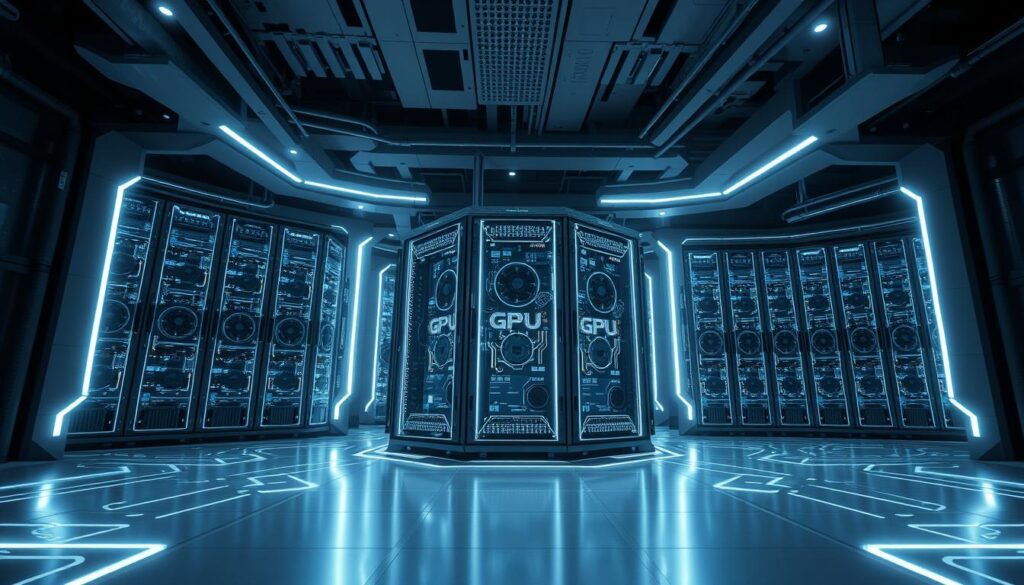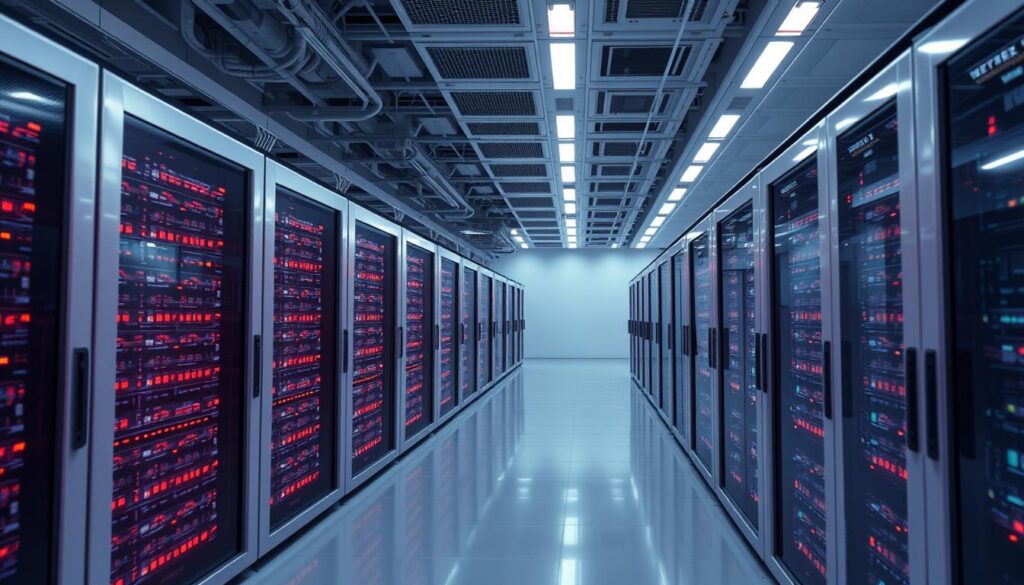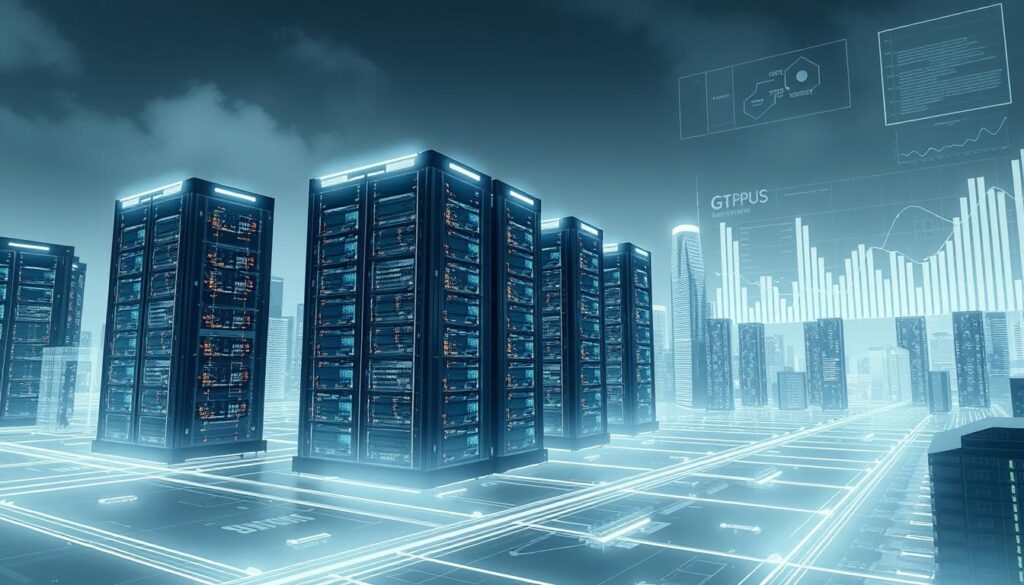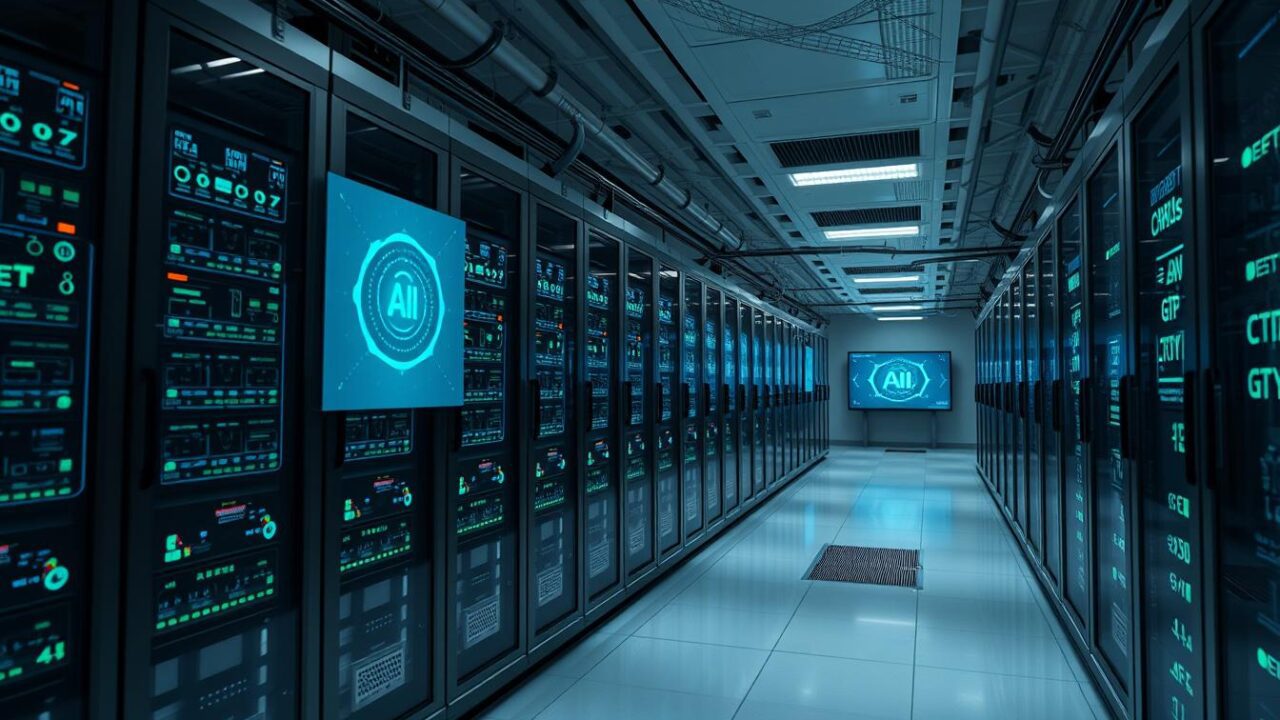Is the cost of cutting-edge AI development putting a strain on your budget? The world of artificial intelligence is evolving fast. Keeping up with the latest hardware can be tough. GPU rental for AI solutions is changing the game in cloud computing and AI infrastructure.
In recent years, gpu acceleration has become key for advanced AI projects. The demand for computational power is rising. Traditional hardware ownership models are being challenged. GPU rental services offer a cost-effective way to access high-performance computing without the high cost of ownership.
Think about this: a single high-end GPU like the NVIDIA H100 can cost over $30,000. That’s a big investment, especially with technology’s fast pace of change. GPUs typically lose about 15% of their value each year. By choosing GPU rental, AI developers and startups can avoid these financial challenges and focus on innovation.
GPU rental fits perfectly with AI’s dynamic nature. It lets you scale resources up or down as needed. This is key in AI’s ever-changing world. It’s especially good for startups and small businesses looking to compete with big corporations in AI.
Key Takeaways
- GPU rental offers access to high-performance computing at a fraction of the ownership cost
- Renting GPUs allows for flexible resource allocation based on project needs
- GPU rental services are experiencing rapid growth, with some platforms seeing over 200% year-over-year increases
- Data center GPUs offer greater stability and reliability compared to consumer models
- The trend towards GPU rental aligns with the shift to Opex business models in the 2020s
The Evolution of GPU Computing in AI Development

GPU computing has changed AI development a lot. It has made machine learning hosting and deep learning on demand much better. The move from graphics to AI processing is a big step forward in how we compute things.
From Graphics to AI Processing
GPUs were first used for gaming. Now, they help with complex AI tasks. Their ability to do many things at once is great for image recognition and data analysis. This has made AI research and use much faster.
CUDA and Modern GPU Architecture
NVIDIA’s CUDA platform started in 2006. It let developers use GPUs for more than just gaming. This change has led to big improvements in machine learning hosting. Today, CUDA is key for many AI frameworks, making deep learning faster.
The Rise of Parallel Computing
Parallel computing is key for AI. GPUs are great at doing lots of tasks at once. This is perfect for training big neural networks. It has helped a lot in areas like natural language processing and computer vision.
The GPU market is growing fast. In Q3 2024, spending on cloud services, including AI, was $83.8 billion. This is a 23% jump from the year before. It shows how important GPU computing is for AI now.
Understanding the Current AI Infrastructure Landscape

The AI industry is facing a big challenge in managing computer resources. Companies spend more than 80% of their budget on these tools. This shows how important gpu rental and hosting by the hour have become.
AI model development has grown a lot in computer usage. Since 2010, the need for computers has doubled every 5.7 months. This fast growth means we need more advanced chips, like Nvidia’s H100 and A100.
Because of the lack of top GPUs, new solutions have come up. GPU rental services are now a good option. They are flexible and save money for businesses of all sizes.
Elon Musk once compared obtaining GPUs to acquiring drugs, emphasizing their scarcity.
Cloud providers like AWS, Google Cloud, and Microsoft Azure are leading the market. They offer strong platforms for AI development. This meets the growing need for large-scale computer resources.
AI Infrastructure as a Service (AIaaS) is changing the game. It offers affordable solutions that cut down on upfront costs. This model lets companies adjust AI resources as needed, avoiding waste.
The move towards gpu rental and hosting by the hour brings many benefits:
- Lower initial investment costs
- Reduced operational expenses
- Enhanced scalability and flexibility
- Improved security and compliance
- Access to the latest AI technologies
As the AI infrastructure world changes, businesses need to think about their needs, budget, and flexibility. They should pick the right solution carefully.
The New Hosting Model GPU Rental for AI Solutions – Fad or Not?

GPU rental is changing how we develop AI. It makes high-performance computing easy for all businesses. The demand for AI solutions is driving the growth of the gpu hosting market.
Market Analysis and Growth Projections
The AI industry has seen a big increase in funding, with €17.59 billion invested. This shows how important GPU resources are for AI. Companies like Lambda Labs and Voltage Park have gotten €463 million each to grow their data centers.
Industry Adoption Rates
More businesses are using GPU rental services. They find it cheaper than buying GPUs. For example, renting an Nvidia A100 40GB from CoreWeave costs €2.21 per hour or €1,112 monthly.
Expert Opinions and Predictions
Experts say GPU rental will make AI development more open. The Nvidia h100 is in high demand. Microsoft’s deal with CoreWeave for OpenAI model training shows the shift to rented GPUs.
“GPU rental is not just a fad. It’s a game-changing model that’s here to stay, making AI development more accessible and cost-effective for businesses of all sizes.”
Companies like Coolhousing have been hosting AI, ML, and HPC servers for four years. The trend of using GPU rental for AI solutions is growing. This model is shaping the future of AI development, offering scalable and efficient solutions.
Cost-Benefit Analysis of GPU Rental vs. Purchase
Choosing between renting or buying GPUs for AI tasks requires a detailed cost-benefit analysis. High-end models can cost over $30,000, making the initial purchase expensive. Let’s look at the financial sides of both options.
Initial Investment Comparisons
Buying GPUs means a big upfront cost. Renting, on the other hand, offers flexibility with lower initial costs. Cloud computing platforms offer pay-as-you-go models. This lets businesses scale resources as needed for projects.
Long-term Financial Implications
GPUs lose about 15% of their value each year. Long-term costs include electricity, maintenance, and upgrades. Renting avoids these ongoing expenses, making it good for businesses with changing needs.
ROI Calculations for Different Scenarios
Return on investment changes with usage patterns and project length. For small projects or businesses with variable workloads, renting GPUs often gives better ROI. But, companies with constant, high AI workloads might find buying more cost-effective over time.
“Cloud computing has revolutionized how businesses approach AI infrastructure, offering unprecedented flexibility and cost-efficiency.”
The choice between renting and buying GPUs depends on your AI needs, budget, and long-term plans. Weigh these factors to make a decision that fits your business goals.
Cloud-Based GPU Solutions: A Technical Overview
Cloud-based GPU solutions have changed the game for AI infrastructure. They give users access to top-notch hardware without the big upfront costs. These platforms offer flexible resources that grow with your machine learning needs.
The cloud-based GPU market has grown fast. Cloud spending jumped from $145 billion in 2017 to $560 billion in 2023. Big names like AWS, Microsoft Azure, and Google Cloud now control 66% of the cloud spending, up from 47% in 2016.
Cloud-based GPU solutions bring many benefits to businesses and researchers:
- Access to the latest hardware, like NVIDIA A100 GPUs
- Scalability to fit your project needs
- Less maintenance as providers handle updates
- Support for various AI frameworks and customizable workloads
While big players lead, specialized GPU cloud providers offer competitive prices and focused services. They claim to be cheaper than the big names, often without extra data egress fees.
“The surge in demand for GPU cloud hosting services spans industries such as AI, machine learning, scientific research, and gaming.”
As AI infrastructure grows, cloud-based GPU solutions are key to its future. They offer flexibility and power, helping businesses grow their AI projects. This makes advanced computing available to more people.
Scaling AI Operations with Rented GPUs
GPU rental has changed AI operations, making them more flexible and cost-effective. This change lets businesses grow their AI without big upfront costs.
Resource Allocation Strategies
Using rented GPUs well is all about smart resource allocation. Cloud servers offer a pay-as-you-go model, cutting down on hardware costs. This makes businesses more agile.
Companies can easily scale up or down as needed. This is a big plus of cloud computing.
Performance Optimization
Improving performance is vital for AI on demand. On-premise GPU servers can be expensive and hard to manage. But cloud GPUs save a lot of money in the long run.
They can cut costs by up to 50% compared to on-premise solutions.
Load Balancing Techniques
Spreading the load across multiple GPUs is key for using resources well. This is especially true for big models or high-demand tasks. The rise in AI has increased GPU demand a lot.
NVIDIA’s value has jumped by $2 trillion in just 13 months.
“The ability to scale cloud infrastructure based on project needs is a game-changer for AI operations.”
GPU rental costs have dropped by over 40% in the last year. This makes it easier for all kinds of businesses to use. But, the field is changing fast.
Big tech companies are making their own AI chips, like Google’s TPUs. These are cheaper than NVIDIA GPUs for some tasks.
Security Considerations in GPU Rental Services
GPU rental services offer powerful computing for AI projects, but security is key. Using hosting by the hour or high-end GPUs like the NVIDIA H100 means protecting sensitive data is vital. Providers use strong measures to keep user privacy and data safe.
Secure data transfer and isolated compute environments are the core of GPU rental security. Multi-tenant setups need extra protection to stop data leaks between users. This is critical when using advanced hardware like the NVIDIA H100.
Following industry standards and regulations is crucial for GPU rental security. Meeting GDPR for data protection is a must. Users should look into encryption and access control when using rented GPUs for AI projects.
- Implement secure data transfer protocols
- Use isolated compute environments
- Apply robust multi-tenant safeguards
- Ensure compliance with industry regulations
- Utilize encryption and access control
The global GPUaaS market is expected to hit $7 billion by 2025. This shows how important secure GPU rental services are. Big names like AWS, Google Cloud, and Microsoft Azure offer many security features. When picking a provider for hosting by the hour, look at their security and performance.
“Security in GPU rental services is not just about protecting data, it’s about building trust in the AI development ecosystem,” says a leading cybersecurity expert.
As AI projects grow more complex, finding the right balance between security and performance is essential. The NVIDIA H100, with its advanced design, offers both high performance and security. It’s a top pick for secure GPU rental services.
Popular GPU Rental Platforms and Their Offerings
GPU hosting and cloud computing have changed AI development. Now, there are many platforms for renting GPUs. Each has its own features and prices.
Platform Comparisons
Vast.ai is known for its easy-to-use interface and good prices. It starts GPU rentals at $0.20 per hour. You can choose from RTX 3090 and A100. On the other hand, AWS and Google Cloud offer big ecosystems but are harder to learn.
Pricing Models
Prices differ on each platform. Google Colab has a free tier with 12 hours/day of GPU time. The Pro plan costs $9.99/month. Kaggle gives 30 hours/week of free GPU time. For more power, Vultr starts at about $90/month for GPU rentals.
Service Features
Many platforms have ready-to-use environments and automatic scaling. AWS SageMaker Studio Lab gives 4 hours of free GPU time daily. Lightning AI offers 22 GPU hours/month with customizable setups. Saturn Cloud’s free tier includes 64GB RAM or a T4 GPU with 16GB RAM.
“AI GPU rentals are cost-effective, flexible, accessible, and relieve users of maintenance worries,” states a recent industry report.
Choosing the right platform depends on your project, budget, and customization needs. With options from free tiers to high-end GPU rentals, businesses can find what they need for AI development.
Best Practices for GPU Rental Implementation
Setting up GPU rental for AI needs careful planning. To get the most out of it, follow some key steps.
First, plan your resources well. Choose the right GPUs for your needs to save money and boost performance. Look at your workloads and pick the best GPU setups.
Next, make your code work better with GPUs. Improve your algorithms to use GPU power well. This can make your AI models train faster.
Managing data well is also key. Make your data loading and prep smooth. This can make training faster and more efficient.
- Use containerization technologies like Docker
- Monitor and adjust resource allocation regularly
- Implement robust security measures
Containerization keeps your setup consistent. It makes scaling and managing your AI setup easier.
Keep an eye on how you use resources. Change how you use GPUs based on how they’re doing. This keeps costs down and performance up.
Security is very important with shared GPUs. Use strong encryption and control who can access your data. This keeps your AI projects safe.
“Effective GPU rental implementation can lead to a 30% reduction in AI infrastructure costs while improving model training speeds by up to 40%.”
Following these best practices helps you get the most from GPU rental. It makes your AI setup scalable, cost-effective, and secure.
Impact on AI Startups and Small Businesses
GPU rental is changing the AI game for startups and small businesses. It makes high-performance computing accessible. This lets smaller companies compete with big players in AI.
Cost Reduction Benefits
GPU rental saves a lot of money. Startups don’t have to spend a lot on hardware upfront. For example, renting an NVIDIA H100 GPU costs just $1 to $2 an hour. This is much cheaper than the $50,000 or more needed for a data center.
Accessibility Improvements
Deep learning on demand makes top AI resources available to all. Startups can use the same powerful GPUs as big tech companies. This lets them test and improve their ideas fast. It’s led to more AI innovations in many areas.
Growth Opportunities
GPU rental lets startups grow their AI work easily. They can change their computing power as needed. This helps them save money and do better work. For example, Perplexity grew to a $1 billion value by using resources wisely.
“GPU rental has opened doors for AI innovation that were previously closed to small businesses. It’s not just about cost savings; it’s about having the tools to compete on a global scale.”
As the AI world looks to grow in 2024, startups using GPU rental are ready. They can take advantage of new chances and make big strides in AI.
Advanced GPU Technologies for AI Development
The world of AI is changing fast, and GPU technologies are leading this change. Now, thanks to gpu rental and hosting by the hour, developers can easily get top-notch hardware for their AI projects.
Tensor cores are a big deal in AI processing. These special units in GPUs speed up deep learning tasks. This makes them perfect for training big neural networks. With gpu rental, AI developers can use this power without spending a lot upfront.
MIG technology is another big step forward. It lets one GPU be split into smaller parts, each running its own tasks. This is great for those using hosting by the hour, as it makes the most of rented GPU time.
NVLink is changing how GPUs talk to each other. It makes communication between GPUs super fast, which is key for training big language models. As gpu rental services update, users get to use these new techs without always needing new hardware.
GPU rental and hosting by the hour are making advanced AI techs more accessible. This lets startups and researchers compete with big tech companies.
The future of AI looks even more promising with new techs like neuromorphic and photonic computing coming. These will likely make AI even more powerful. And gpu rental services will help make these new techs available to more people.
Managing Resources in a Rental Environment
GPU hosting has changed the AI world, giving us access to top-notch computing. The nvidia h100 is a key example of this change. It’s important to manage resources well to get the best performance and keep costs down.
Monitoring and Optimization
It’s key to watch how rented GPUs perform in real-time. Tools that show how much they’re being used help find problems. For example, checking a group of nvidia h100 GPUs can show how to spread workloads better.
Cost Control Strategies
Setting up alerts for your budget and using spot instances for less urgent tasks can save money. You can also set up auto-scaling to keep things running smoothly when demand changes. This way, you use your GPUs like the nvidia h100 efficiently and save money.
Resource Scheduling
Good scheduling means spreading workloads across different GPUs and locations. This way, you use your GPUs to their fullest potential. It’s especially important for high-performance GPUs like the nvidia h100, where every bit of work matters.
“AI factories, due to their high power density, are significantly smaller than traditional data centers, with an estimated size of around 10,000 sq ft compared to over one million sq ft for conventional data centers,” notes Sean Farney, Vice President of Data Center Strategy at JLL.
In summary, managing resources in GPU hosting needs smart planning, the right tools, and flexible scheduling. By using these strategies, companies can get the most out of GPUs like the nvidia h100 while keeping costs low and operations running smoothly.
Future Trends in GPU Rental Services
The world of GPU rentals is about to change a lot. Cloud computing is getting better, and so are gpu acceleration technologies. These changes are making AI and machine learning projects more efficient.
AI is now helping manage resources better. Cloud providers use smart algorithms to make sure GPUs are used right. This leads to better performance and saving money for users. Predictive scaling is also exciting. It helps use resources more wisely, cutting down on waste and boosting system performance.
More specialized GPUs for specific AI tasks are coming. This is good news for companies wanting to improve their AI work. The global GPU as a service market is growing fast. It’s expected to jump from $3.23 billion in 2023 to $49.84 billion by 2032, growing 35.8% each year.
There’s also a big push for sustainability. Cloud providers are focusing on green data centers and energy-saving tech. This move is in line with growing environmental worries and could bring more eco-friendly GPU rental choices.
- AI-assisted resource management optimizes GPU allocation
- Predictive scaling improves system performance
- Specialized GPU offerings for specific AI tasks
- Sustainable and energy-efficient data centers
The future of GPU rental services is looking up. With these new developments, businesses will get more powerful, efficient, and custom AI and machine learning solutions. Cloud computing and gpu acceleration together are opening up new doors in artificial intelligence.
Case Studies: Successful GPU Rental Implementations
GPU rental services have changed the game for ai infrastructure across many fields. Let’s look at real examples of how companies have used machine learning hosting to innovate and work more efficiently.
Enterprise Success Stories
Financial institutions have jumped on the GPU rental bandwagon for quick fraud detection and risk checks. A big bank cut the time to process complex financial models from 24 hours to just 10 minutes with Intel Xeon Scalable processors. This big change helps them make decisions faster and serve customers better.
Research Applications
Academic institutions are using GPU rentals for cutting-edge research. The University of Bristol found that NVIDIA Tesla V100 GPUs made deep learning workloads for drug discovery 15-20 times faster than CPUs. This huge speed-up cut model training time from days to hours, speeding up vital medical research.
Startup Transformations
AI startups in healthcare and self-driving cars have grown thanks to flexible GPU resources. One image classification startup cut processing time from 1.5 hours to 3 minutes with AWS EC2 P3 instances and NVIDIA V100 GPUs. This big improvement let the company quickly improve their product and stay ahead in the market.
These stories show how GPU rental is useful in many areas. By 2025, the global GPU as a Service market is expected to hit $7 billion. This growth is driven by the increasing need for high-performance computing in AI and machine learning.
Conclusion
The rise of GPU rental for AI solutions is changing the game. It’s making deep learning on demand more accessible. This shift is helping businesses and researchers get the computing power they need.
GPU rental services are growing fast worldwide. The Asia Pacific is leading the charge, while Europe is pushing AI forward. South America and the Middle East are also seeing big changes, thanks to their plans for AI.
The cost of AI development is changing fast. Training costs for machine learning systems are going up by 0.49 orders of magnitude each year. By 2040, the biggest training runs could cost over $233 billion. This shows how important GPU rental is for keeping AI affordable and within reach.
Looking ahead, GPU rental for AI is a game-changer. It makes advanced computing available to more people. This helps innovation in many fields and lets all kinds of organizations use AI. The flexibility and growth of this model will keep shaping AI development, making it easier for more people to use.
Want to hire me as a Consultant? Head to Channel as a Service and book a meeting.

